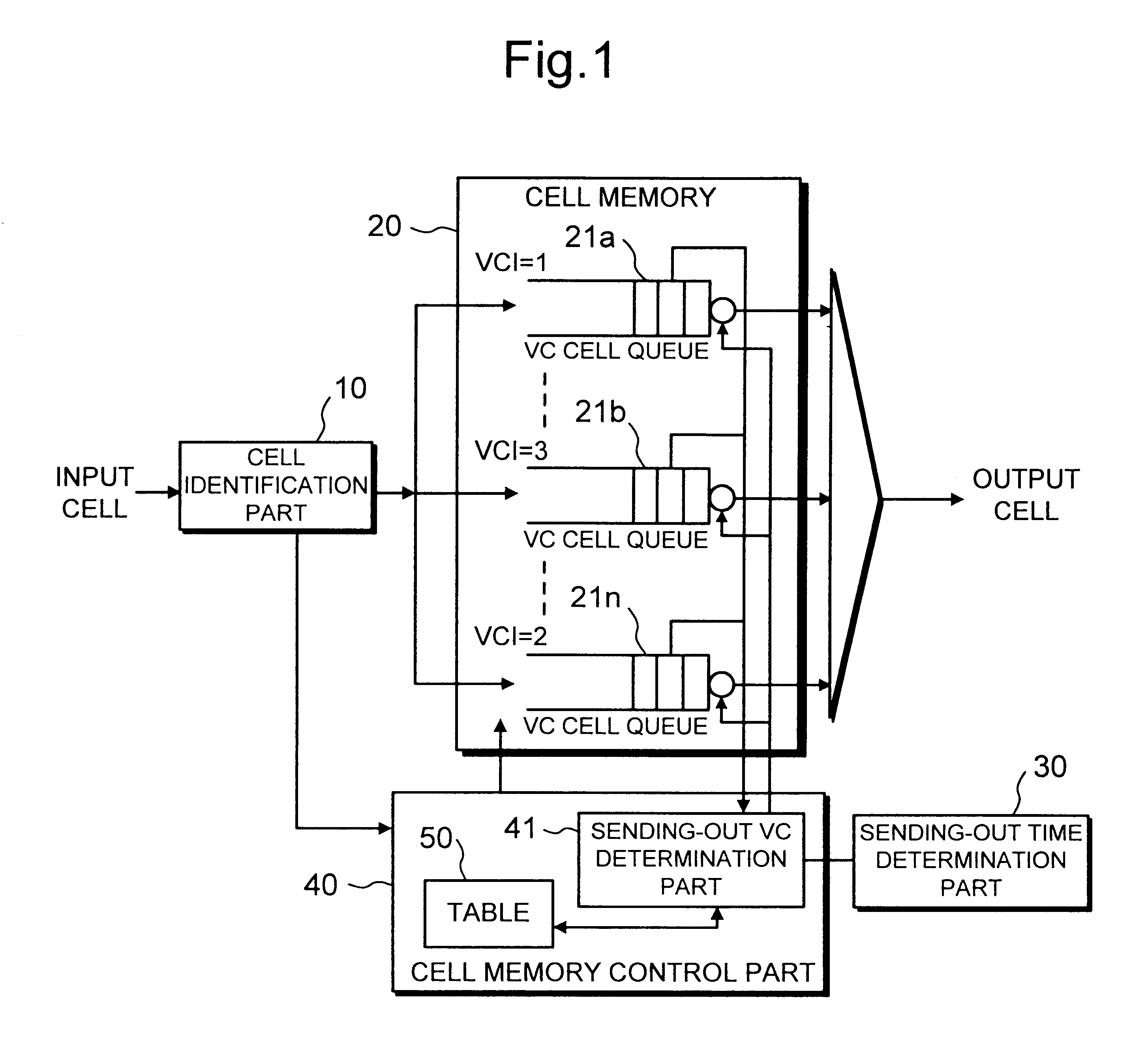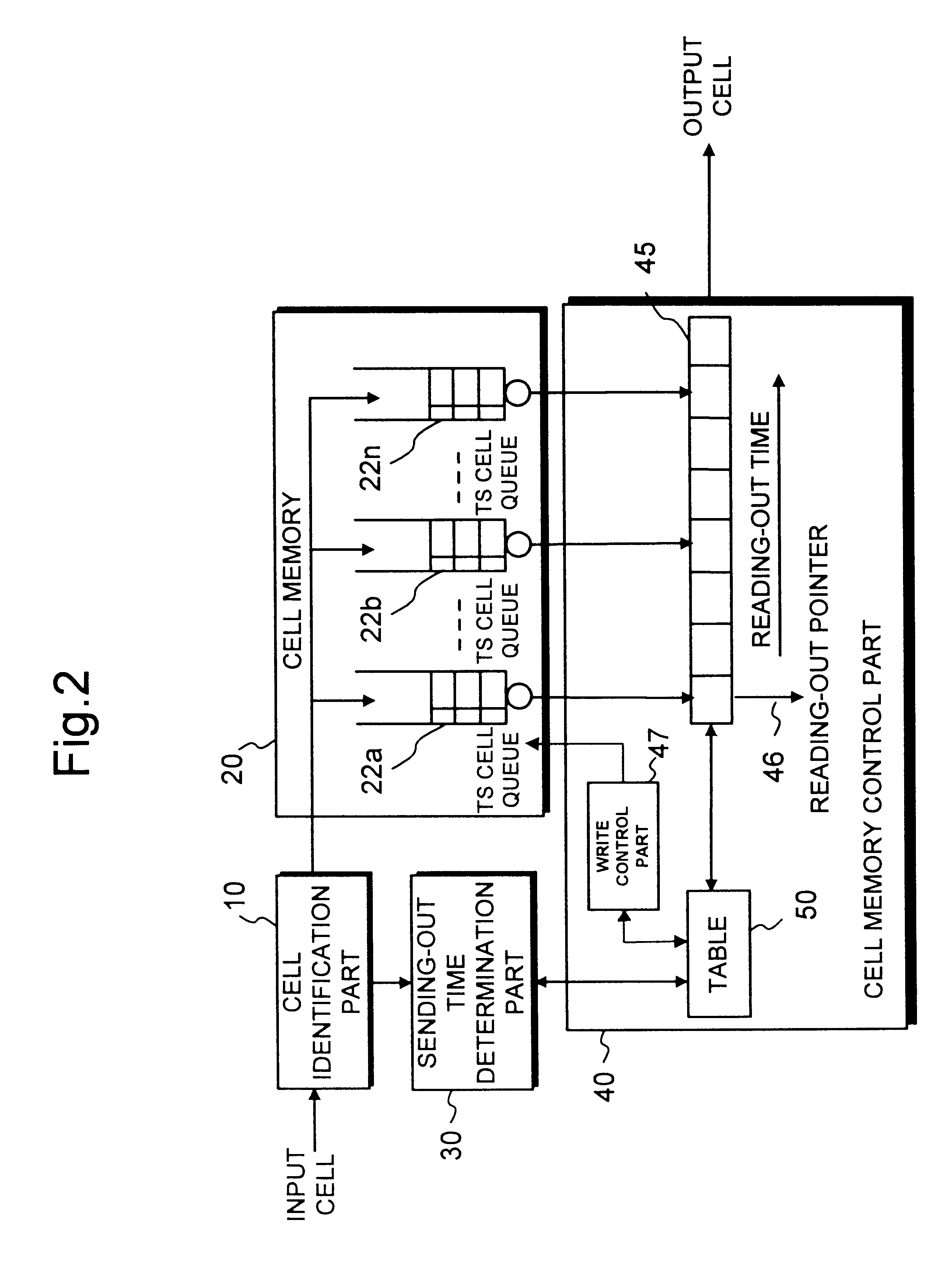Traffic shaper
a shaper and traffic technology, applied in the field of traffic shapers, can solve the problems of not considering the traffic characteristics, not performing the shaping cell intervals for each virtual path or virtual channel, and not improving the coefficient of utilization of network resources
- Summary
- Abstract
- Description
- Claims
- Application Information
AI Technical Summary
Benefits of technology
Problems solved by technology
Method used
Image
Examples
first embodiment
Next, the operation of the present invention will be described in detail with reference to the drawings. Referring to FIG. 4, when a virtual connection is newly established, the reading-out priority is determined so that the smaller the CDVT of the virtual connection is, the higher the reading-out priority is. The priority table 51 is then renewed. In FIG. 4, a younger priority number is given to a higher reading-out priority virtual connection.
Referring to FIGS. 1, 4 and 5, when a cell arrives this traffic shaper, after the virtual connection of the cell is identified by the cell identification part 10, the cell is stored in the corresponding queue of virtual connection among the VC cell queue 21a-n. Upon storing, if the empty flag of the corresponding virtual connection of the sending-out time schedule / buffer state table 52 is empty (E), it is changed to full (F).
The stored cell is read out from the VC cell queue under instructions by an output competition control operation of the...
second embodiment
Next, the present invention will be described in detail with reference to the drawings.
The construction of the second embodiment is the same as that of the first embodiment of the present invention shown in FIG. 1, so the description is omitted. It means that the priority table 51 and the sending-out time schedule / buffer state table 52 are also provided for the second embodiment. And also, operations shown in FIG. 7 and FIG. 8 are applied in the same manner as the first embodiment.
FIG. 10 is a flow chart showing a selection process of a virtual connection for which a cell is to be sent out of the second embodiment of the present invention. Referring to FIG. 10, a point of difference from the operation of the first embodiment of the present invention shown in FIG. 9 is the point in which a process (step S407) that the priority of the selected virtual connection, for which an operation of a cell sending-out has been completed, is renewed to the lowest position among the group of virtu...
third embodiment
Next, the present invention will be described in detail with reference to drawings.
FIG. 2 is a block diagram showing the construction of a traffic shaper that is the third embodiment of the present invention. In FIG. 2, parts same as or similar to those of the above FIG. 1 are denoted by the same references. Referring to FIG. 2, the third embodiment of the present invention comprises a cell identification part 10, a cell memory 20, a sending-out time determination part 30 and a cell memory control part 40.
The cell memory 20 comprises a time slot (TS) cell queue 22a-n that is a virtual queue for each sending-out scheduled time.
The cell memory control part 40 comprises a table 50, reading-out time slots 45 corresponding to sending-out scheduled times, a reading-out pointer 46 and a write control part 47. Hereinafter, the detail of the structure of the table 50 will be shown.
FIG. 6 is an explanatory view showing an example of a time slot / buffer state table 53 provided in the third embo...
PUM
 Login to View More
Login to View More Abstract
Description
Claims
Application Information
 Login to View More
Login to View More - R&D
- Intellectual Property
- Life Sciences
- Materials
- Tech Scout
- Unparalleled Data Quality
- Higher Quality Content
- 60% Fewer Hallucinations
Browse by: Latest US Patents, China's latest patents, Technical Efficacy Thesaurus, Application Domain, Technology Topic, Popular Technical Reports.
© 2025 PatSnap. All rights reserved.Legal|Privacy policy|Modern Slavery Act Transparency Statement|Sitemap|About US| Contact US: help@patsnap.com



